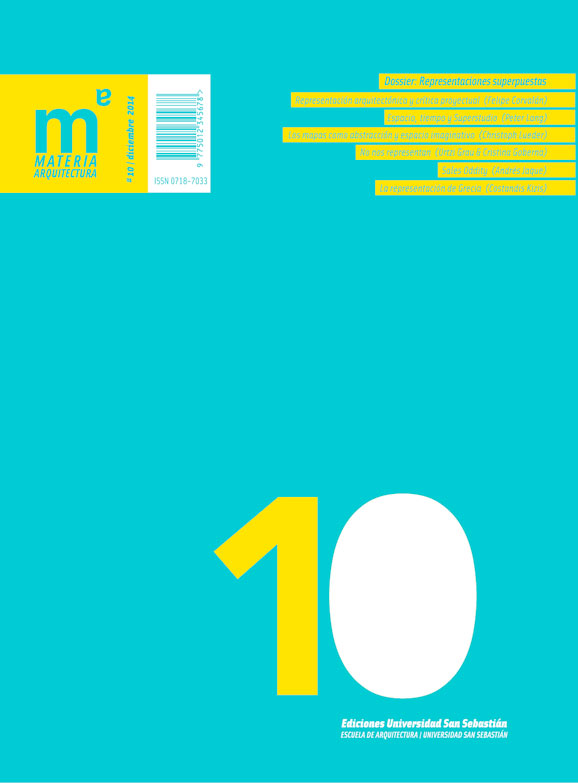Representing Greece: A story on marble
Barra lateral del artículo
Palabras clave:
Contenido principal del artículo
Resumen
In 1938, young architects Alexandra and Dimitris Moretis were commissioned by the Greek State to design and build the pavilion of
Greece in the New York World Fair of 1939. The Greek representation in the “World of Tomorrow” Expo was mainly a reminder of the
past: a pavilion with marble showcasing important ancient Greek sculptures (both in copies and originals). The link between ancient
Greek civilization and modernism was still at stake, and “Greekness” was the vehicle for modernism in interwar Greece. Twenty seven
years later, Greek-Canadian architect Ninos Chryssopoulos won the competition for the Greek pavilion for the Montreal 67 Expo, with
a proposal of perfectly aligned white cubes around a courtyard. Minimal in form, the pavilion was presented as an invocation of both
the Cycladic vernacular and the ancient courtyard prototypes; yet there were voices asking for more “Greekness.” What changed and
what stayed the same in the course of thirty years, in the architectural representation of the Greek State abroad
Detalles del artículo
Materia Arquitectura proporciona acceso inmediato y gratuito a todos los contenidos de esta edición electrónica, publicada simultáneamente con la edición impresa. Materia Arquitectura no cobra honorarios a los autores por ningún concepto.
Todos los contenidos de esta edición electrónica se distribuyen bajo licencia Creative Commons de “Atribución-Copartirigual 4.0 Internacional” (CC-BY-SA).
La licencia Creative Commons permite el acceso libre e inmediato al contenido y permite que cualquier usuario lea, descargue, copie, distribuya, imprima, busque o genere enlaces a los textos completos de los artículos, permitiendo también que estos puedan ser rastreados para indexarlos, pasarlos como datos a software o usarlos para cualquier otro propósito legal. Asimismo, la licencia otorga derechos de uso a quienes a su vez utilicen una licencia abierta (Creative Commons o equivalente).
Los derechos de los textos y las imágenes publicadas pertenecen a sus autores, quienes otorgan a Materia Arquitectura la licencia para su uso. La gestión de los permisos y la autorización de publicación de las imágenes (o de cualquier material) que contenga derechos de autor y sus consecuentes derechos de reproducción en esta publicación es de exclusiva responsabilidad de los autores de los artículos.
Toda vez que mencionen su origen, los autores son libres de distribuir sus artículos por otros medios. Cualquier reproducción total o parcial del material deberá citar su procedencia.
Descargas
Citas
MARTINOS, S. (2014). "The overall character of the composition was inspired by Aegean architecture": The mask of place on the Greek Pavilion in Venice. 1er Congreso de arquitectura histórica, 22-24 de mayo, 2014, Atenas (Versión griega de las actas disponible en: http://www.aht.asfa.gr/index.php/2014-11-06-16-22-49).
MORETIS, D. (15 de octubre de 1941). Report on the Greek participation in the 1939 World Fair. The Alexandra and Dimitris Moretis Personal Archives.
MORETIS, D. (18 de mayo de 1966). Personal letter to Ninos Chryssopoulos. The Alexandra and Dimitris Moretis Personal Archives.
ROCHE, M. (2000). Mega-events and Modernity: Olympics and Expos in the Growth of Global Culture. Londres: Routledge.
VAGENAS, N. (1997). Modernism and Greekness. Heraclión: Crete University Press.
VAN HAGENDOREN, P. (14 de noviembre de 1956). Letter of the director of foreign section of the Expo 58 to the Greek consul. Alexandra and Demitris Moretis Archives.
Artículos más leídos del mismo autor/a
- Costandis Kizis, La representación de Grecia: Una historia en mármol , Materia Arquitectura: Núm. 10 (2014): Materia Arquitectura 10 (Diciembre/December 2014)
